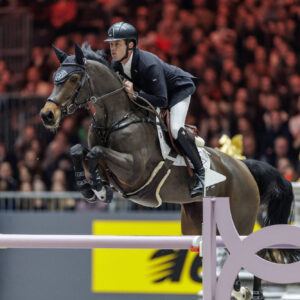Don’t worry, we won’t be on poles forever.
Last week, my four-year-old Warmblood True was clearing a three-inch raised pole by three feet. I redirected him to a different task to buy myself an evening of thought, in hopes of finding some solution.
A good general tactic with training problems is to take one step back to an easier part of the exercise the horse had mastered. So I ask True to cross the raised pole at a walk instead of a trot. He lifts his dinner-plate hooves WAY high the first few times.
I bring him around in a circle for another try without rewarding him. When he walks over with a normal step, he gets his praise and strokes and a Happy Mama. Yippee!
After a few days of this, the problem was solved. When I next trotted him to the raised pole, he stepped right over without touching… but also without flying!
The next step is to string poles together in a sequence. You’ve seen sets of four poles spaced apart so that the horse trots through them in a straight line with one foot landing between each pair of poles, right? That’s where we’re headed.
Go to a ground pole your horse has already mastered. Set another pole on the ground about 4 ½ feet in front of it. These are “inside” measurements—4 ½ feet covering just the ground between the inner side of each pole. Inches make a difference in this exercise, so measure the distance with a tape.
Four and half feet is standard for horses of about 16 to 17 hands in height. Larger horses need a little more space, smaller horses a little less. Ponies? About a foot less.
One of the most common mistakes occurs when riders ask a horse to trot a pole sequence that’s set too close together. This human error creates an impossible task for the horse. He cannot possibly trot through tight poles without touching or landing on them.
Some people even try to get horses to “pick up their feet” and perform the sequence by using spurs, crops, raised poles, or larger heavy poles. Forcing the issue like this scares the horse into worse behavior and undermines his trust in you. It’s like commanding a person to fly like an eagle, then punishing when she cannot.
So, set the poles properly!
At first, I ask True just to walk through the sequence of two poles. Don’t be concerned if your horse touches the poles or seems uncoordinated—they’re set for trotting, not walking, so there will be some clumsiness.
True seems bored walking the sequence, so we trot to it. Success!
Practice back and forth a few times. Love on your horse for good behavior. If all goes well, add a third pole, and so on until you reach four. The most important thing is the horse’s attitude—calm, relaxed, softly attentive—not the number of poles.
How long does this take? That’s up to the horse.
Some master it in one session. Others get nervous and bounce through the poles at a half canter with their heads in giraffe mode and legs like pogo sticks. A few balk at the approach or try to evade the task by moving sideways.
Many youngsters are inconsistent—reaching plateaus of good performance, then dropping into an unexpected valley. When there are problems, use the tools in your kit: 1) reduce to an easier version of the task, 2) redirect to a different successful task and think about the problem later, and 3) check your skills.
Hmmm, check your skills? Horses pick up human emotions—especially fear or anxiety—very quickly. As you approach multiple poles, are you a little nervous? Are you trying to teach a skill that is new to you? Is your body stiff in an effort to help the horse maintain balance over the poles? Are you catching him in the mouth with the bit as he springs slightly upward in his steps? Are you using too much leg, not enough, or perhaps more pressure in one leg than the other? Are you holding your breath through the exercise? Is your riding atmosphere tense or distracting?
These are common problems that every advanced rider has dealt with at some point. They have to be solved before you and your team partner can proceed.
Related reading:
Brain-Based Horsemanship is a weekly column that chronicles Janet Jones, PhD, and her journey with True, a Dutch Warmblood she trained from age three using neuroscience best practices. Read more about brain-based training in Jones’ award winning book Horse Brain, Human Brain.

A version of this story originally appeared on janet-jones.com. It is reprinted here with permission.


 October 18, 2023
October 18, 2023 



























